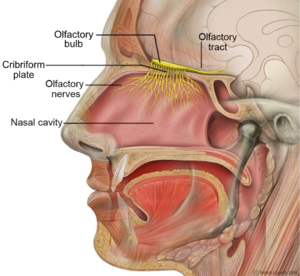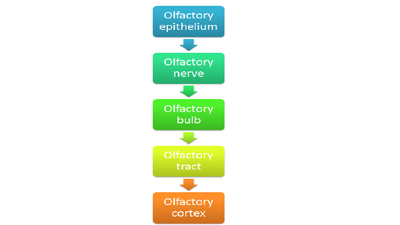Olfactory Nerve
Description[edit | edit source]
The Olfactory Nerve is also known as the first cranial nerve. It is a sensory nerve that functions for the sense of smell.
Root[edit | edit source]
The olfactory nerve terminates at the olfactory bulb, located just above the ethmoid bone and below the frontal lobe. The olfactory bulb acts as a relay center for the transmission of the impulses from the olfactory nerve to the olfactory tract and then to the cerebral cortex (olfactory cortex).[1]
Branches[edit | edit source]
The olfactory nerve divides into two branches. These are:
- Lateral olfactory nerves- located in the superior nasal concha[2]
- Medial olfactory nerves- located along the nasal septum
Pathway[edit | edit source]
The olfactory epithelium is found in the nasal cavity. This contains different types of cells,including: olfactory sensory neurons, microvillar‐capped sustentacular cells, microvillar cells, the Bowman's duct cells, and the basal cells or stem cells.
- The olfactory sensory neurons are bipolar cells that receive the stimuli at its dendrite from the apical pole and conducts them to the axon from basal pole. Groups of 15 to 40 axons are ensheathed with glial cells at the level of the basement membrane, making up a small fascicle.
- These small fascicles converge with other small fascicles giving rise to larger fascicles, known as fila olfactoria.
- These collection of axons crosses the cribriform plate of the ethmoid bone, through its perforations, and reach the brain where it innervates the olfactory bulb.
- The olfactory bulb is a relay station for the transmission of the impulse coming from the olfactory nerve. From the olfactory bulb, impulses then travel through the olfactory tract. The olfactory tract divides into the medial and lateral olfactory striae, then connects to the olfactory cortex.
- The olfactory cortex are the parts of the brain that receive and process the sensory input.[1]
Function[edit | edit source]
The olfactory nerve is a pure sensory nerve that functions for the sense of smell.
Clinical Relevance[edit | edit source]
The olfactory nerve can be damaged through trauma eg TBI; Blunt trauma to the head can lead to laceration of the olfactory nerve as it crosses the ethmoid bone; Infections can also cause damage to the olfactory nerve.
Lesions to the Olfactory Nerve and/or to the Olfactory Pathway can lead to the following symptoms:
- Anosmia- loss of sense of smell
- Hyposmia- decrease ability to detect smell
- Hyperosmia- increased sensitivity to the sense of smell
- Dysosmia- distorted sense of smell or presence of unpleasant smell in the absence of any actual odor (olfactory hallucinations)
Assessment[edit | edit source]
Assessment of the olfactory nerve is readily done either at bedside or in the clinic. Testing of the integrity of the olfactory nerve involves either pinching or blocking of one nostril while the patient is blindfolded or with the eyes closed, then have the patient smell aromatic substances such as coffee, vanilla, cinnamon, etc. Avoid using substances with strong or noxious smell such as alcohol or ammonia. Have the patient identify the substance based on its aroma. Then repeat the same procedure on the other nostril. This is done to compare the sense of smell on both sides.
Treatment[edit | edit source]
Conservative management for olfactory nerve damage secondary to different etiologies is olfactory training.[3][4]
References[edit | edit source]
- ↑ 1.0 1.1 Crespo, C., Liberia, T., Blasco‐Ibáñez, J.M., Nácher, J. and Varea, E. (2019), Cranial Pair I: The Olfactory Nerve. Anat. Rec., 302: 405-427. https://doi.org/10.1002/ar.23816
- ↑ Barral JP, Croibier A, Manual Therapy for the Cranial Nerves, Chapter 10 - Olfactory nerve, Churchill Livingstone, 2009, Pages 59-72, ISBN 9780702031007, https://doi.org/10.1016/B978-0-7020-3100-7.50013-6 [cited 2021 Jan 31] Available at: https://www.sciencedirect.com/science/article/pii/B9780702031007500136
- ↑ Patel, Zara M. The evidence for olfactory training in treating patients with olfactory loss, Current Opinion in Otolaryngology & Head and Neck Surgery: February 2017 - Volume 25 - Issue 1 - p 43-46 [cited 2021 Jan 31] Available at: https://journals.lww.com/co-otolaryngology/Abstract/2017/02000/The_evidence_for_olfactory_training_in_treating.10.aspx doi: 10.1097/MOO.0000000000000328
- ↑ Pekala, K, Chandra, RK, Turner, JH. Efficacy of olfactory training in patients with olfactory loss: a systematic review and meta‐analysis. Int Forum Allergy Rhinol. 2016; 6: 299– 307 [cited 2021 Jan 31] Available at https://onlinelibrary.wiley.com/doi/abs/10.1002/alr.21669









